Critique Submissions‚ July, 2000
This page contains submissions made during July, 2000 from photographers who wished to have their photographs reviewed by the publisher of this site,Michael Reichmann.For additional details see theCritique / Contestpage.
The July winner of a complimentary 1-year subscription theLuminous Landscape Video JournalwasEnrico Pocopagni.
Enrico Pocopagni‚ July, 2000 Contest Winner
Enrico Pocopagni, Genoa (Italy)


Po riverPicture taken in February 2000, roughly at 6:30 p.m. from Gerola’s bridge on the Po, the major italian river. Camera & lens: Mamiya RZ67 with Mamiya-Sekor Z 90 f3.5W Film: Kodak E100VS rated at 100 ISO Light meter: Minolta Spotmeter F Tripod: Manfrotto 141RC tripod Filters: None Time: 8 sec. Aperture: unrecorded Flash: None
VenetiansPicture taken in April 1999, roughly at 7 p.m. near Murano (Venezia) Camera & lens: Nikon F4 with AF Nikkor 300 f4 ED-IF Film: Fuji Velvia rated at 50 ISO Light meter: F4 internal in matrix manual mode Tripod: Handheld Filters: None Time & aperture: unrecorded Flash: None
Professional architect, teacher of Building Mechanics and Technology at high school for surveyors. Theory, History and practice of Photography were my passions from my teenage.Now, photography is not my job, but does have an important part in it.So I consider photography more a cultural activity than a hobby.My favorite subjects are landscapes, especially under particular light, still life and flowers.In my landscapes is almost always present the sign of Man for my main interest is to investigate the relationships between natural world and human history.No need to say that your site is one of the better photography sites I visited ever; very appreciated the possibility for everyone to submit pictures.I hope the love for the beauties of this planet can go far beyond photography, to reach all those that in some degree are responsible of their waste. Michael’s Critique
These two photographs stand out from the other submissions thus far this month. They are beautifully seen and executed. I am particularly taken with the consistency of vision that the two images display. Though photographed in different place at different times with different types of cameras, the use of monochromatic colour unifies them. Enrico has an artist’s eye.
The only suggestions that I would make would be to crop thePo Riverimage slightly at the bottom. A more rectangular format would give it a slightly greater tension and I feel that the removal of the extra ripples would take nothing away from the informational content of the picture.
TheVenetianscould be cropped somewhat more severely. I would crop it on the left side just to the right of the pole and at the bottom just below the wave. Because of the severity of the crop and the fact that this was shot on 35mm, quality might not hold up for a large print though. Overall two very good photographs!
You can add your own comments on Enrico’s photograph on theCritiquesection of ourDiscussion Forum.
Ken Cravillion
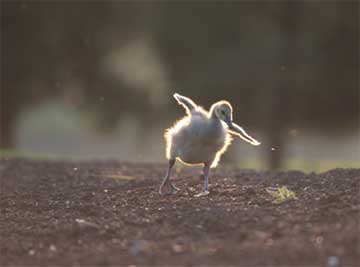
Ken Cravillion
Oshkosh, WI USA
kenc@execpc.com
Canon EOS-1V HS
EF 300 2.8L IS
Fuji Provia F
Ken’s Comment:
This shot was taken at my local park. I was actually shooting a test roll for my then new EOS-1V and this shot came as a nice surprise using P mode to see how good the 1V was.
Michael’s Critique
Ken’s submission has appeal. The chick is quite cute and has been caught in a lovely moment as it apparently practices how to soar.
But, the photograph fails in a number of ways. The out-of-focus foreground is a messy distraction. The horizon line is tilted and the chick’s beak disappears into it’s wing. The image also looks like it could usea bitof spotting.
Having an appealing subject isn’t enough. A good photograph has to work on both the technical and esthetic level.
You can add your own comments on Ken’s photograph on theCritiquesection of ourDiscussion Forum.
Paulo Bizarro
Paulo Bizarropbizarro@cggpt.com



Sunset:EOS 1n, 180 macro, f/3.5, 1/350 sec., E100SW, tripod
Flower:EOS 1n, 180 macro, Provia F, probably f/22 and 1 sec
Spider:EOS 1n, 50 macro, TriX. Exposure unrecorded.
Michael’s Critique
Paulo’s 3 submitted photographs (the rules now say only 1 submission) are each lovely in their own ways. Each is also technically quite nicely done. But, I’ve seen them all before,many times.
So often it’s easy for photographers to feel comfortable with what they’ve done because it breaks no new ground. It’s safe and predictable, and often for this reason boring. Pretty isn’t good enough. Safe isn’t good enough. Paulo has a good eye but needs to be more adventuresome in his subject matter.
You can add your own comments on Paulo’s photograph on theCritiquesection of ourDiscussion Forum.
Boris Buschardt
Boris Buschardt, Berlin,buschardt@zmms.tu-berlin.de

Michael’s Critique
A straightforward perspective and an undramatic subject, but I still think it works. The threatening sky is the key component while the yellow foreground flowers add a graphic counterpoint, both in terms of colour and texture.
Not agreatlandscape photograph, but a good one, well executed.
You can add your own comments on Boris’ photograph on theCritiquesection of ourDiscussion Forum.
Attila Kirjak
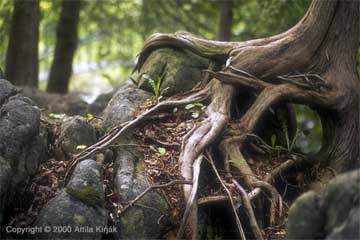
Attila Kirjak, New York
kiru@mailzone.comhttp://www.mailzone.com/~kiru
Technical data: taken with the Canon 1V, 100-400IS on a tripod at 100mm, aperture f5.6, Fuji Velvia.
Location: Just next to Jones falls in Pottawatomi Conservation Area, Canada. I was just leaving the falls when I saw these roots hugging the soft and mushy looking rocks. It was an overcast day, so I could open up and blur out the bridge over the Pottawatomi river.
Michael’s Critique
An interesting attempted visualization, but ultimately unsatisfying. My eye doesn’t know where to go. There’s no central point of interest. Colour doesn’t add much (it could be stronger as a monochrome image), and the out-of-focus foreground rock is distracting and unattractive.
I’m not sure that there’s any way to improve this photograph.
You can add your own comments on Attila’s photograph on theCritiquesection of ourDiscussion Forum.
Cowan Stark
Cowan Stark, from Durham, New Hampshire, USA
Place: Coral Pink Sand Dunes State Park, Utah.Film: Fuji VelviaCamera: Pentax 67Lens: 55mm/4 with polarizerSettings: f/22 (exposure bracketed)Date: Last week of October, 1999Scanner: Minolta Dimage Multi.
Comments: Usually this area is heavily used by ATV’s and dune buggies, but we got there just before sunset just after a windstorm blew through and the tracks were blown over. The setting sun over my right shoulder cast this incredibly warm light on the sand and brought out the ripples. Also over my right shoulder were two guys with view cameras and we were all jockying for postion on our bellies to get the a lowest perspective and yet stay out of each others’ frame! Post scan adjustments in Photoshop included increasing saturation by 10% and unsharp mask not used in the original scan, and that’s about it. Michael’s Critique
Cowan’s photographalmostworks. It is well seen and well executed, but lacks a center. Here is a case where almost everything is working for the photographer; great subject, great light, great equipment. But there’s nothing to draw me in.
My eye follows the ripples upward but then finds the jumbled and confusing cliff face at the top of the frame. The sweep of the distant dune is classic, but it’s too far away to form a meaningful part of the composition.
I’ve shot atCoral Pink Sand Dunes State Parka couple of times as well and not had great success. One of the problems is that there is not much opportunity for elevation, and therefore perspective on the dunes.
You can add your own comments on Cowan’s photograph on theCritiquesection of ourDiscussion Forum.
Raphaël Zeiher
Huningue, France,rzeiher@hotmail.com
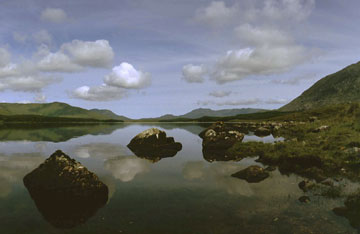
Place: Ireland, Lake District
Camera: EOS 1N RS
Lens: EF 14 f/2,8L
Film: Fuji Velvia
Tripod: Gitzo
Scanner: Nikon LS 2000
I was only there with my 14mm. I couldn’t resist !
Michael’s Critique
Raphaël’s submission is an evocative image with strong appeal. The stillness of the water and the reflections are what make it work so well. It’s probably just me, but I’d be tempted to crop it more as a wide-format image, taking off just a bit of sky and cropping the bottom somewhat beneath the foreground rock.
Since the photograph was taken with an extreme wide-angle 14mm lens it’s evident that Raphaël used proper technique in keeping his horizon centered to avoid linear distortion. A very nicely realized photograph.
You can add your own comments on Raphaël’sphotograph on theCritiquesection of ourDiscussion Forum.
The Netherlandse-mail:r.tielenburg@wanadoo.nl
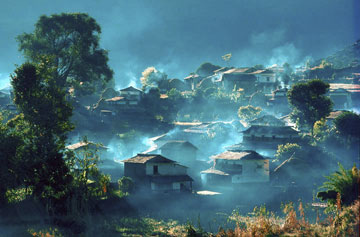
I shot this picture during a trekking in Nepal. In the early morning light I made use of the branch of a tree which blocked the sunlight from my zoomlens. Looking for the perfect composition, I spend about 15 minutes before I made this photo. Because I made so many pictures especially with backlight conditions, my friends nicknamed me "Mr. Backlight"!
I used a Canon T90 in combination with a Canon FD 80-200 zoomlens and Kodachrome 64.The 80-200 zoomlens is my workhorse in combination with a 35 mm "Tilt&Shift"lens
Michael’s Critique
Rene’s photograph is exceptional. My first reaction to the cyan colour of the mist in the village was that this print must be seriously out of colour balance. But looking more closely, especially to the foliage in the lower right, I believe that this colour is real.
I like the way the image is framed by the large tree on the left and the smaller ones on the right. I wouldn’t change a thing. Lovely image.
You can add your own comments on Rene’sphotograph on theCritiquesection of ourDiscussion Forum.
Lou Cohen
Long Island, NY USA
LOUCOH@aol.co
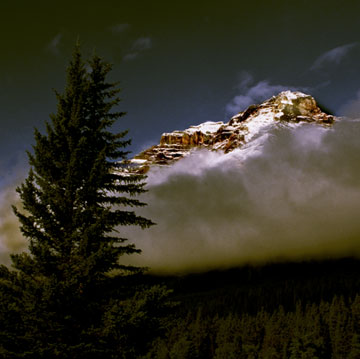
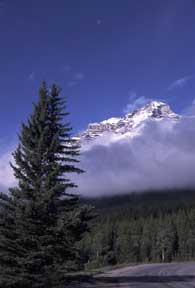 (Original photograph)
(Original photograph)
Mt. Norquay, outside Banff, Alberta
Nikon 8008, Ektachrome Elite Extra Color (EBX), 1/60 @ f8, handheld 50mm f1.8AF Nikkor
The original image was taken in daylight, during aclearing storm. I enjoy ‘working’ an image in Photoshop this way, much as a sculptor ‘works’ a mound of clay. I have been widely criticized for the techniques shown here, as some feel the result is not photography in its truest form. However, I see little difference between the techniques used in Photoshop, and those used by good printers in a traditional wet darkroom. Is this ‘cheating’? Hmmmm… At least I resisted the temptation to insert a fullmoon in the upper left!
Michael’s Critique
Lou has created a very appealing image here. It’s as dramatic and mysterious as aTurnerpainting.
His stated concerns about the legitimacy of using available tools to bend an image to his liking are groundless. Many ofAnsel Adamsbest photographs were only realized on paper after days of toil in the darkroom, altering contrast, brightness‚ burning and dodging. (My position on this subject is best summarized in my essayWhat Photography Isn’t.)
One suggestion would be to not have darkened the sky so much in the area behind the tree. I want to see it a bit more clearly separated from the black sky. (This would also make the picture less unnatural looking, and thus less open to criticism from unreconstructed traditionalists.)
You can add your own comments on
Roman Gill
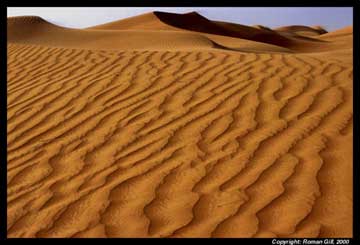
Name: Roman Gill
City: Vancouver, BC
Country: Canada
Email: rgill@vanhosp.bc.ca
Tech Data: Nikon F3/T , 20-35 f/2.8 set at ~f11 1/125th ss, handheld, Provia 100F
Location: Sand dunes outside of Dubai in the United Arab Emirates. My first time photographing sand dunes.
This is about my 3rd year since taking up photography as a hobby. More of my photos can be viewed at: http://www.photocritique.net/cgi-bin/phtg?ROMAN+GILL
Michael’s Critique
Sand dunes can be a real pleasure to photograph. Roman’s photograph was taken at the right time of day‚ late afternoon by the look of it. The cross light provides both texture and saturated colour.
The top of the frame is cropped too closely. A bit more blue sky is needed to balance the large expanse of orange sand. Speaking of which, there simply is too much foreground. While it’s interesting, it dominates the composition too much. Even simply cropping a quarter off the bottom of the frame would help.
The distant dunes are sensuous, but too small. I think I can see a bit of sand blowing off the tops of the ridges. Shot with a slightly longer lens these would have become more prominent and the distant dunes would have been turned into an intrinsic part of the composition rather than a minor player. For the above reasons this is a good shot, but not a great one.
You can add your own comments on Roman’s photograph on theCritiquesection of ourDiscussion Forum.
Pete Dickson
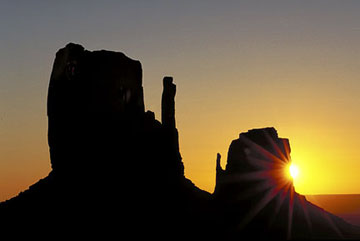
Pete Dickson, Cincinnati, OH USA
dickson.pn@pg.com
Camera: Nikon F4
Lens: AF Nikkor 80-200/2.8 f/11 or f/16 I reckon.
Tripod: Gitzo 320 with Arca-Swiss B1
Film: Probably Elitechrome 100
Just in case there’s someone in the world who doesn’t know it, this is in MonumentValley Tribal Park.This is quite a bit after the sun rose over the horizon. I always maintain thatcomposition is a matterof finding the right point in space to put your camera. It’s usually aceases to amaze me how fast the sun really moves (ok, how fast we really move).I had to walk into the shadowof the Butte to create a new sunrise.
Michael’s Critique
Monument Valley is one of my favourite locations. I’ve shot there several times and just conducted a Workshop there this past Spring. While possible one of the most photographed geological formations in the American Southwest, thus making it difficult to come up with an original perspective, Pete has done a great job in capturing this view ofThe Mittensparticularly considering that there were no clouds to aid his composition.
I find almost nothing critical to say about this image. Well seen and well realized.
You can add your own comments on Pete’s photograph on theCritiquesection of ourDiscussion Forum.
You May Also Enjoy...
Canon’s 8 Megapixel Alternatives
In mid-March Canon loaned me two cameras for testing. The1D Mark IIand thePowershot Pro1. As I spent two weeks shooting with both cameras, looking at
